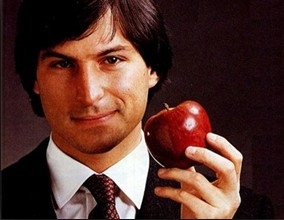Thus they were destined to clash, especially after Jobs was ejected from the Lisa project in September 1980 and began casting around for someplace else to make his mark. It was inevitable that his gaze would fall on the Macintosh project. Raskin’s manifestos about an inexpensive machine for the masses, with a simple graphic interface and clean design, stirred his soul. And it was also inevitable that once Jobs set his sights on the Macintosh project, Raskin’s days were numbered. “Steve started acting on what he thought we should do, Jef started brooding, and it instantly was clear what the outcome would be,” recalled Joanna Hoffman, a member of the Mac team.
因此,他们两人之间注定会有冲突,尤其是乔布斯在1980年9月被逐出丽萨项目后,他开始寻找其他能让自己创造辉煌的地方。不可避免地,他的目光落到了麦金塔项目上。拉斯金“为大众制造一台拥有简单图形界面和简洁设计的廉价电脑”的宣言触动了乔布斯的心灵。同样不可避免的是,一旦乔布斯盯上了麦金塔项目,拉斯金的日子也就到头儿了。“史蒂夫开始将他的想法灌输给我们,杰夫陷入了苦闷的思考之中,会有怎样的结果一目了然。”Mac团队的成员乔安娜·霍夫曼(JoanneHoffman)回忆说。
The first conflict was over Raskin’s devotion to the underpowered Motorola 6809 microprocessor. Once again it was a clash between Raskin’s desire to keep the Mac’s price under $1,000 and Jobs’s determination to build an insanely great machine. So Jobs began pushing for the Mac to switch to the more powerful Motorola 68000, which is what the Lisa was using. Just before Christmas 1980, he challenged Burrell Smith, without telling Raskin, to make a redesigned prototype that used the more powerful chip. As his hero Wozniak would have done, Smith threw himself into the task around the clock, working nonstop for three weeks and employing all sorts of breathtaking programming leaps. When he succeeded, Jobs was able to force the switch to the Motorola 68000, and Raskin had to brood and recalculate the cost of the Mac.
第一次冲突是关于拉斯金钟爱的低性能微处理器——摩托罗拉6809。这又一次成为了拉斯金将Mac价格控制在1000美元以下的愿望与乔布斯建造一台完美机器的决心之间的冲突。于是,乔布斯开始强烈要求Mac换上性能强劲的摩托罗拉68000,这也是当时丽萨使用的微处理器。1980年圣诞节前,在没有告知拉斯金的情况下,乔布斯给了伯勒尔·史密斯一个考验战:设计一台使用摩托罗拉68000的样机。就像自己的偶像沃兹尼亚克一样,史密斯不分昼夜地投入到了任务当中,工作了3个星期,在编程中运用了各种惊人的创举。在他成功之后,乔布斯如愿让所有Mac换上了摩托罗拉68000,拉斯金只能郁闷地重新计算Mac的成本。
There was something larger at stake. The cheaper microprocessor that Raskin wanted would not have been able to accommodate all of the gee-whiz graphics—windows, menus, mouse, and so on—that the team had seen on the Xerox PARC visits. Raskin had convinced everyone to go to Xerox PARC, and he liked the idea of a bitmapped display and windows, but he was not as charmed by all the cute graphics and icons, and he absolutely detested the idea of using a point-and-click mouse rather than the keyboard. “Some of the people on the project became enamored of the quest to do everything with the mouse,” he later groused. “Another example is the absurd application of icons. An icon is a symbol equally incomprehensible in all human languages. There’s a reason why humans invented phonetic languages.”
还有更大的麻烦等着拉斯金。他想要的那款廉价微处理器无法完全驾驭那些酷炫的图形——窗口、菜单、鼠标等他们在施乐PARC见过的东西。当初正是拉斯金说服大家去参观了施乐PARC,而且他本人也很喜欢位图显示和窗口的概念。但是他并不迷恋那些漂亮的图形和图标,也很反感用鼠标取代键盘的想法。“项目里的一些人过于追求用鼠标完成所有操作了,”他后来埋怨说,“还有一个例子就是滥用图标,在所有的人类语言中,图标都是一种很让人费解的符号。人类发明表音文字是有原因的。”
Raskin’s former student Bill Atkinson sided with Jobs. They both wanted a powerful processor that could support whizzier graphics and the use of a mouse. “Steve had to take the project away from Jef,” Atkinson said. “Jef was pretty firm and stubborn, and Steve was right to take it over. The world got a better result.”
拉斯金以前的学生比尔·阿特金森这次站到了乔布斯的阵营中。他和乔布斯都想使用更强大的处理器,以支持炫丽的图形效果和鼠标的运用。“史蒂夫不得不把这个项目从杰夫手里夺走,”阿特金森说,“杰夫是个很坚定、很固执的人,史蒂夫把项目夺过来是正确的,世界得到了一件更好的产品。”
The disagreements were more than just philosophical; they became clashes of personality. “I think that he likes people to jump when he says jump,” Raskin once said. “I felt that he was untrustworthy, and that he does not take kindly to being found wanting. He doesn’t seem to like people who see him without a halo.” Jobs was equally dismissive of Raskin. “Jef was really pompous,” he said. “He didn’t know much about interfaces. So I decided to nab some of his people who were really good, like Atkinson, bring in some of my own, take the thing over and build a less expensive Lisa, not some piece of junk.”
乔布斯和拉斯金之间的分歧不仅仅是产品理念上的。他们的个性也互不相容。“我认为他是那种喜欢发号施令的人,”拉斯金曾经说,“我感觉他不值得信赖,他受不了别人发现他的不足。他也不喜欢那些不将他奉若神明的人。”乔布斯对拉斯金也很不肩。“杰夫非常的自命不凡,”他说,“他对界面并没有太多了解。所以我决定从他的人马里挖来几个精兵强将,比如阿特金森,再让我手下的几个人加入进来,接管整个项目,然后造出一台低价版的丽萨,我可不想制造垃圾电脑。”
Some on the team found Jobs impossible to work with. “Jobs seems to introduce tension, politics, and hassles rather than enjoying a buffer from those distractions,” one engineer wrote in a memo to Raskin in December 1980. “I thoroughly enjoy talking with him, and I admire his ideas, practical perspective, and energy. But I just don’t feel that he provides the trusting, supportive, relaxed environment that I need.”
团队中的一些人觉得与乔布斯共事实在太困难了。“正是乔布斯给整个团队带来了压力、杈力争斗和激烈的冲突,而不是化解这些让人分心的事情。”一名工程师在1980年12月份交给拉斯金的一份备忘录中写道,“我很喜欢和他交谈,也很仰慕他的思想、实用性的观点和充沛的精力。但我觉得他提供不了我需要的那种充满信任、支持和氛围轻松的工作环境。”














